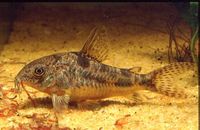Peppered Cory (Corydoras paleatus)
From The Aquarium Wiki
Peppered Cory
Corydoras paleatus
76 Litres (20 US G.)
5.1-7.6cm (2-3 ")
Freshwater
6.0 - 7.5
18 -25 °C (64.4-77°F)
5-10 °d
1:2 M:F
15-25 years
Family
Callichthyidae
This animal is available captive bred
Contents
Additional names
- Pepper Cory, Peppered Cory, Salt and Pepper Cory
Additional scientific names
- Callichthys paleatus, Corydoras maculatus, Corydoras marmoratus, Corydoras microcephalus, Silurus 7-radiatus, Silurus quadricostatus
Origin
- South America: Lower Paraná River basin and coastal rivers in Uruguay and Brazil.
Sexing
- When properly conditioned, the difference between the male and female Corydoras is usually quite evident. Females will look a lot wider when viewed from the top, as they have a larger underbelly. Males are also shorter in length than females.
Breeding
- One of the first types of Corys to be spawned in aquaria.
- One of the easiest Corys to spawn in captivity.
- It is recommended to drop the temperature 5-6° and do a 25% water change with cooler water to induce spawning (this simulates rain fall).
- Feeding quality foods like brine shrimp or bloodworms helps to condition the fish for spawning.
- Scrape eggs off the glass and place them in a small tank with an air stone.
- Eggs normally hatch between 5 and 8 days time.
- Feed the fry freshly hatched brine shrimp or commercial powder food (Cyclop-eeze, etc.). (they grow a lot faster on live food).
- The male will try to get his body in front of the female whilst she is on the substrate. He positions himself midway across her head in a classic 'T' shape with his anal opening against her mouth.
- If the female is interested the female attaches her mouth to the male's genital opening and directly drinks his sperm. The sperm pass through her intestine and are discharged together with eggs into the ‘pouch’ formed by her pelvic fins.[1]
Tank compatibility
- Very peaceful community fish. Will not intentionally bother tank inhabitants, however their bumbling about the tank may bother more delicate fish or other bottom dwellers. Are best kept in groups of 5-6 or more.
Diet
- As with most Corydoras, these fish will eat most food which sinks to the bottom of the tank. Sinking algae pellets should be supplemented with flake food or other sinking foods like catfish pellets.
- Be aware these fish do have a carnivorous side to them and love foods such as Bloodworm and Brine Shrimp. Vegetable-based foods offer little nutrition to them. They will also eat any dead, dying, or even injured fish, that sit on the substrate too long. They're very opportunistic!
Feeding regime
- These fish are most active at night, so feeding once before lights out is typically enough. Though they can easily be persuaded to feed during the day. Since they are slower eaters they should be allowed at least 30 minutes to consume their food.
Environment Specifics
- Requires a sand or small gravel substrate and prefers a planted tank. Keeping a cory on sharp or large gravel can lead to damage to their barbels, which when infected will make it hard for the cory to find food.
- Corys are sensitive to salt, as with other scaleless fish, adding salt to the tank will cause them harm.
Behaviour
- The Corydoras group of fish frequently gulps air. This is normal and is not a cause for concern. If too little room is available between the water surface and the hood (<2") the fish may hit the hood. They hold the air in their stomach and the thin lining dissipates the oxygen.
- This fish likes the company of its own kind. It is recommended to keep at least 2, or better yet, several of the same species. The more you have, the more secure they are and the more you will see them.
- They are known to 'blink' their eyes to the amazement of onlookers. The Cory has the ability to tilt its eye down to examine the nearby substrate.
Identification
- Typical Corydora in shape, these fish's bodies are are mottled in various shades of grey and brown. An albino variation has been seen but is uncommon.
Special notes
- These fish are incredibly docile, very peaceful and are a wonderfully easy fish to own. However it is a remarkably little known fact that Corydoras species have a very sharp barb just under each eye, one in the adipose fin, and a large one in the front of their dorsal fin.
- The fish uses these barbs to protect itself from being swallowed by a larger fish. Therefore when using a net to catch these fish, be prepared for the Cory to become caught up in the mesh of the net. Also, ensure you don't try to catch this fish in your hand!
- What is also little known is that most species of Corydoras have a poison gland in their barbs which causes fish which try to eat them to get stung. This causes the attacking fish to suffer a lot of pain rather like a jellyfish sting. Needless to say this causes an annoying, but harmless, irritant to aquarists skin if they get stung also.
- The Cory has a sensitive sense of smell and its barbels allow it to taste food hidden in the substrate.
- These fish are armoured, not scaled, catfish. They have two rows of overlapping bony plates running down each side and large plates covering their head. Indeed, the name Corydoras is derived from the Greek kory (helmet) and doras (skin).
Pictures
Videos
| Peppered Corydoras feeding: | Fry and adult feeding: |
References
External links
- Fishbase (Mirrors:
 )
)
- Scotcat
- Corydorasworld
- I love Corydoras
- Planet Catfish
- Seriously Fish
- Peppered Catfish Fact Sheet: [1]



